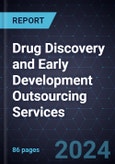M&As, Partnerships, and the Shift Toward an End-to-end CRDMO Model will Boost Sector Expansion
The global pharmaceutical research and development (R&D) pipeline accounts for more than 21,000 molecules, as of April 2023, indicating a 5.8% hike over 2022, with more than 6,100 molecules in active development. In general, however, the pharma/biopharma industry has stagnated with respect to R&D activity. Overall R&D expenditure totals about $276.81 billion, with a slow 2.5% growth between 2023 to 2024. Decline in the year-on-year growth rate is the result of a shift in focus from COVID-19 therapies to more mainstream therapies across oncology, neurology, respiratory, and many more conditions, which is resulting in overall market normalization with respect to growth rates. Furthermore, the industry witnessed a decline in the average return on investment (ROI) for R&D to as low as 1.2%, and the peak sales per asset valued just above $350 million, indicating a need to build more efficient drug development processes with the implementation of newer technologies.
Of total R&D expenditure, the top 10 pharma companies accounted for just 4% to 5% of the pipeline, while the top 25 contributed to less than 10%. In contrast, small-to-mid segment and emerging biopharma players (companies with 1 or 2 molecules in the pipeline) are the major contributors, accounting for more than 16% of the active pipeline. As a result, the demand for outsourcing activities is on the rise globally, with contract research organizations (CROs) and contract development and manufacturing organizations (CDMOs) contributing to the strong industry growth.
Moreover, advancements in multiple emerging biotechnology platforms (e.g., RNA technology, protein degradation [PROTAC], and antibody engineering technologies) coupled with the application of digital health technologies in the form of artificial intelligence (AI) and machine learning are supporting unprecedented innovation, ascertaining the increased success of a molecule. This activity is improving the partnership landscape across the global drug discovery and preclinical development industry.
Overall, the sector is witnessing an emergence of specialized lab testing and bioanalytical CROs. With techniques such as next-generation sequencing (NGS), high throughput screening (HTS), and many more crucial to drug development, a steady rise in CRO and central lab partnerships is underway. To add to this, several specialized bioinformatics CROs are emerging and creating greater partnership opportunities. Last, the larger CROs have developed separate lab testing divisions that allow them to focus on specific drug discovery and preclinical development testing services.
Moving forward, CROs/CDMOs will likely focus on targeted scale up of preclinical capabilities through cross-industry partnerships and academic partnerships, ascertaining knowledge transfer to pharma companies through out-licensing opportunities, thereby supporting greater innovation while transitioning from a vendor-ship to partnership model.








